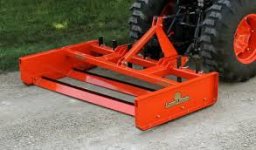/pine
Super Star Member
- Joined
- Mar 4, 2009
- Messages
- 15,059
Based on the picture...just about any grading implement would do the job...but it must be done with the side link adjusted to put some tilt on the blade or whatever...
Personally I would pitch the entire lane to the ditch on the right looking at the pic...IMO a rear blade would do the job fastest, starting by recovering as much gravel from the ditch shoulder as possible...
A box blade or a landscape rake would also be viable options...I have never used a LPGS so I can't comment on their use but if they can be tilted by adjusting a side link it might even be the best option?
Again, the key to keeping a smooth lane is preventing the runoff from running down the grades (hills) and eroding ruts as is evident in the pic...
Personally I would pitch the entire lane to the ditch on the right looking at the pic...IMO a rear blade would do the job fastest, starting by recovering as much gravel from the ditch shoulder as possible...
A box blade or a landscape rake would also be viable options...I have never used a LPGS so I can't comment on their use but if they can be tilted by adjusting a side link it might even be the best option?
Again, the key to keeping a smooth lane is preventing the runoff from running down the grades (hills) and eroding ruts as is evident in the pic...
